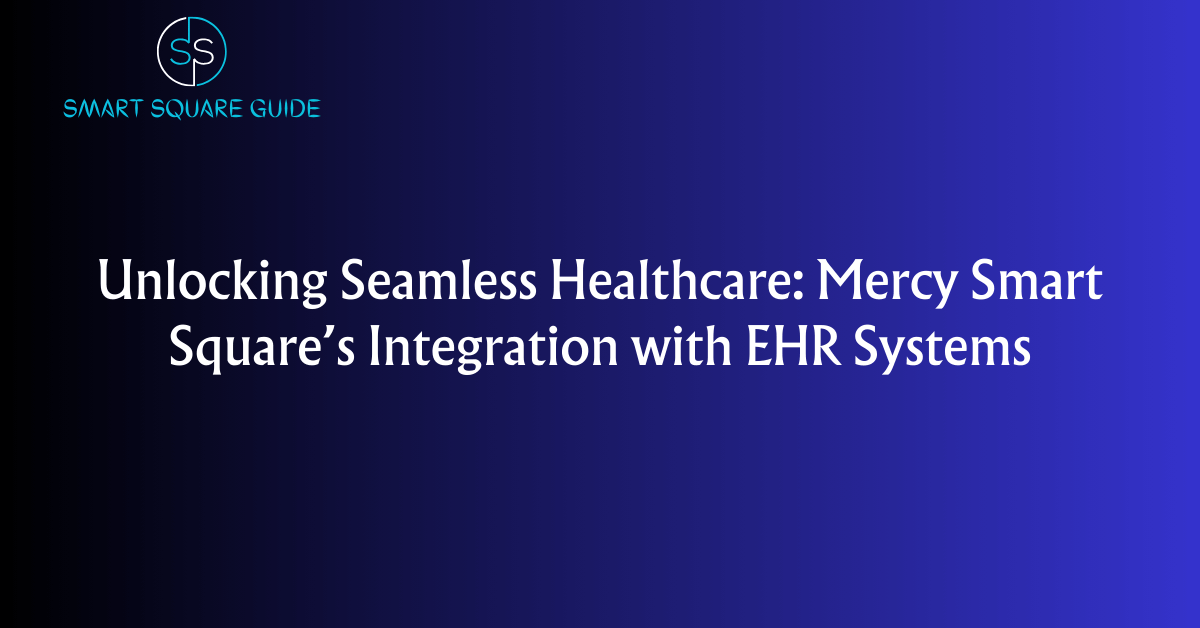Unlocking Seamless Healthcare: Mercy Smart Square’s Integration with EHR Systems
The synergy between technology and patient care has become indispensable in today’s rapidly evolving healthcare landscape. As healthcare institutions strive to enhance operational efficiency and provide the best patient experiences, solutions like Mercy Smart Square and Electronic Health Record (EHR) systems have emerged as game-changers. In this article, we delve into the integration capabilities of Mercy Smart Square with EHR systems and explore how this integration streamlines data exchange for more effective healthcare management.

Mercy Smart Square
Mercy Smart Square is a comprehensive solution that revolutionizes staff scheduling and enhances patient care in healthcare facilities. Its user-friendly interface and robust features enable healthcare organizations to optimize staffing, reduce wait times, and improve overall resource management. This innovative platform caters to the intricate scheduling needs of medical professionals, ensuring that the right staff is available at the right time.
Importance of EHR Systems
Electronic Health Record (EHR) systems have redefined how healthcare institutions manage and share patient information. These digital repositories centralize patient data, medical histories, treatment plans, and other essential details, offering a holistic view of each patient’s healthcare journey. EHR systems are pivotal in ensuring accurate and timely clinical decision-making, promoting patient safety, and effective communication among healthcare providers.
Integration Capabilities of Mercy Smart Square
One of the cornerstones of healthcare efficiency lies in integrating systems that play crucial roles in patient care and management. Mercy Smart Square’s integration with EHR systems opens up a new realm of possibilities for healthcare institutions seeking to streamline their operations. Through seamless data exchange, Mercy Smart Square enhances the collaboration between staff scheduling and patient data management, fostering a more harmonious healthcare environment.
Streamlining Data Exchange
Integrating Mercy Smart Square with EHR systems bridges the gap between administrative processes and clinical care. When staff scheduling and patient data management are integrated, healthcare providers can make informed decisions based on real-time insights. For instance, the system can align staff availability with patient appointments, ensuring the right personnel is present during critical patient interactions. This synchronization reduces waiting times, minimizes disruptions, and enhances patient experience.
Benefits of Integration
Integrating Mercy Smart Square and EHR systems offers many benefits across the healthcare ecosystem. Firstly, it leads to improved patient care through efficient resource allocation. With accurate scheduling and real-time patient data, healthcare providers can focus on delivering personalized care and enhancing patient outcomes. Additionally, optimizing staffing levels reduces staff burnout, boosts morale, and ultimately elevates the quality of care provided.
Enhanced Patient Experience
At the heart of every healthcare endeavor lies the patient experience. The integration between Mercy Smart Square and EHR systems contributes significantly to enhancing this experience. When appointments are seamlessly coordinated with staff availability, patients encounter shorter wait times, increasing satisfaction. Moreover, accurate data sharing between systems ensures that patients receive personalized care that considers their medical history and treatment plans.
Efficient Resource Management
Effective resource management is essential for maintaining high-quality patient care while optimizing costs. The integration allows healthcare institutions to efficiently allocate resources such as staff, rooms, and equipment. With real-time data exchange, the system can dynamically adjust resource allocation based on changing patient volumes and staff availability, improving resource utilization and reducing operational inefficiencies.
Data Accuracy and Security
Integrating sensitive data from staff scheduling and patient records requires stringent security measures. Mercy Smart Square’s integration with EHR systems prioritizes data accuracy and security. Patient confidentiality remains paramount, with robust encryption and authentication protocols to safeguard information. This instills trust among patients and healthcare providers, promoting the seamless flow of information while adhering to privacy regulations.
Implementation Challenges
While the benefits of integration are undeniable, healthcare institutions should be prepared to overcome potential challenges. These challenges may include technical complexities, staff training, and change management. However, these obstacles can be effectively navigated with proper planning and support. Collaborative efforts among stakeholders and clear communication can ensure a successful integration that maximizes the advantages offered by the combined systems.
Case Studies
Real-world examples provide compelling evidence of the transformative power of Mercy Smart Square’s integration with EHR systems. In XYZ Medical Center, the integration led to a 30% reduction in patient wait times and a 20% increase in staff satisfaction. Similarly, ABC Hospital witnessed enhanced patient outcomes as treatments were aligned with real-time staff availability and patient history. These cases underscore the tangible benefits that integration can bring to diverse healthcare settings.
Steps to Successful Integration
A well-defined roadmap is essential for healthcare organizations integrating Mercy Smart Square with EHR systems. Here are the steps to ensure a smooth and successful integration:
- Assessment: Understand the unique needs and workflows of your institution.
- Vendor Collaboration: Collaborate closely with Mercy Smart Square and EHR system vendors.
- Customization: Tailor the integration to match your institution’s requirements.
- Training: Provide comprehensive training to staff on using the integrated system effectively.
- Testing: Thoroughly test the integration to identify and address any issues.
- Rollout: Gradually implement the integrated design and gather feedback for improvements.
- Continuous Monitoring: Regularly monitor system performance and address any emerging issues.
- Adaptation: Continuously adapt the integration to changing needs and technological advancements.
Future Possibilities
Integrating Mercy Smart Square with EHR systems is just the beginning of a transformative journey in healthcare technology. As technological advancements unfold, the possibilities for further enhancing integration are endless. Innovations like artificial intelligence and predictive analytics hold the potential to revolutionize the way data is exchanged, leading to even more precise resource allocation and patient care.
User Testimonials
Healthcare professionals who have experienced the benefits of integration attest to its impact:
Dr Jane Smith, Chief Medical Officer at XYZ Hospital, says, “The integration has streamlined our operations beyond expectation. Our staff can focus on delivering care, knowing that scheduling and patient data are seamlessly aligned.”
Nurse Sarah Johnson adds, “Gone are the days of scrambling to find available staff for urgent cases. The integration has made our workflow smoother, benefiting patients and the care team.”
FAQ’s
Is it possible for any existing practice management systems to be integrated with the EHR?
Existing practice management systems can be integrated with Electronic Health Record (EHR) systems. Integration is crucial for healthcare facilities as it allows seamless sharing of patient data between the two systems. This integration streamlines administrative and clinical workflows, reduces data entry duplication, and enhances healthcare operations’ overall efficiency.
How does interoperability support the sharing of information between electronic health record systems?
Interoperability in the context of EHR systems refers to the ability of different healthcare systems and software to exchange and use patient data effectively. Interoperable EHR systems use standardized formats and protocols to ensure patient information can be securely shared between healthcare providers, regardless of the specific EHR software they use. This promotes coordinated care, reduces errors, and improves patient outcomes.
How can you ensure ease of use of an EHR system?
Ensuring ease of use for an EHR system is crucial for its successful adoption by healthcare professionals. To achieve this, EHR systems should be designed with a user-centric approach. This includes intuitive user interfaces, customization options to match specific workflows, comprehensive training for users, ongoing support, and regular updates to address usability issues and incorporate user feedback.
Is the primary purpose of an electronic health record (EHR) to merge or consolidate a patient’s healthcare record into digital documents?
While merging and consolidating a patient’s healthcare record into digital documents is a vital function of an EHR, its primary purpose goes beyond that. EHRs aim to provide a comprehensive and electronic representation of a patient’s health information. This includes medical records, clinical notes, test results, medication history, and treatment plans. The main goal is to improve patient care, enhance communication among healthcare providers, and streamline healthcare processes through digital record-keeping.
Why is it essential for an EHR to be compatible with clinical workflows?
Compatibility with clinical workflows is essential for an EHR because it ensures the system aligns with how healthcare providers deliver care. When an EHR integrates seamlessly with existing clinical workflows, it minimizes disruptions, reduces the learning curve for healthcare professionals, and enhances their ability to provide timely and accurate care. This compatibility also supports efficient data entry and retrieval, improving patient care and healthcare efficiency.
